A Quad-Port Nature-Inspired Lotus-Shaped Wideband Terahertz Antenna for Wireless Applications
Abstract
:1. Introduction
2. Quad-Port THz Antenna Design Methodology
3. Results
3.1. Scattering Parameters
3.2. Radiation Characteristics
3.3. MIMO Diversity Characteristics
3.4. Comparative Analysis
4. Conclusions
Author Contributions
Funding
Data Availability Statement
Conflicts of Interest
References
- Tripathi, S.; Sabu, N.V.; Gupta, A.K.; Dhillon, H.S. Millimeter-Wave and Terahertz Spectrum for 6G Wireless. In Computer Communications and Networks; Springer: Cham, Switzerland, 2021; pp. 83–121. [Google Scholar] [CrossRef]
- Attaran, M. The impact of 5G on the evolution of intelligent automation and industry digitization. J. Ambient. Intell. Humaniz. Comput. 2021, 14, 5977–5993. [Google Scholar] [CrossRef] [PubMed]
- Dangi, R.; Lalwani, P.; Choudhary, G.; You, I.; Pau, G. Study and Investigation on 5G Technology: A Systematic Review. Sensors 2021, 22, 26. [Google Scholar] [CrossRef] [PubMed]
- Singh, R.; Lehr, W.; Sicker, D.; Huq, K.M.S. Beyond 5G: The Role of THz Spectrum. In Proceedings of the 47th Research Conference on Communication, Information and Internet Policy, Washington, DC, USA, 19–21 September 2019. [Google Scholar] [CrossRef]
- Malhotra, I.; Jha, K.R.; Singh, G. Terahertz antenna technology for imaging applications: A technical review. Int. J. Microw. Wirel. Technol. 2018, 10, 271–290. [Google Scholar] [CrossRef]
- Huang, Y.; Shen, Y.; Wang, J. From Terahertz Imaging to Terahertz Wireless Communications. Engineering 2023, 22, 106–124. [Google Scholar] [CrossRef]
- Petrov, V.; Pyattaev, A.; Moltchanov, D.; Koucheryavy, Y. Terahertz band communications: Applications, research challenges, and standardization activities. In Proceedings of the 2016 8th International Congress on Ultra Modern Telecommunications and Control Systems and Workshops (ICUMT), Lisbon, Portugal, 18–20 October 2016; pp. 183–190. [Google Scholar] [CrossRef]
- Jamshed, M.A.; Nauman, A.; Abbasi, M.A.B.; Kim, S.W. Antenna Selection and Designing for THz Applications: Suitability and Performance Evaluation: A Survey. IEEE Access 2020, 8, 113246–113261. [Google Scholar] [CrossRef]
- Chen, S.; Liang, Y.-C.; Sun, S.; Kang, S.; Cheng, W.; Peng, M. Vision, Requirements, and Technology Trend of 6G: How to Tackle the Challenges of System Coverage, Capacity, User Data-Rate and Movement Speed. IEEE Wirel. Commun. 2020, 27, 218–228. [Google Scholar] [CrossRef]
- Wallace, J.; Jensen, M. Mutual coupling in MIMO wireless systems: A rigorous network theory analysis. IEEE Trans. Wirel. Commun. 2004, 3, 1317–1325. [Google Scholar] [CrossRef]
- Malathi, A.C.J.; Thiripurasundari, D. Review on Isolation Techniques in MIMO Antenna Systems. Indian J. Sci. Technol. 2016, 9, 1–10. [Google Scholar] [CrossRef]
- Khalid, M.; Naqvi, S.I.; Hussain, N.; Rahman, M.; Fawad; Mirjavadi, S.S.; Khan, M.J.; Amin, Y. 4-port MIMO antenna with defected ground structure for 5G millimeter wave applications. Electronics 2020, 9, 71. [Google Scholar] [CrossRef]
- Jilani, S.F.; Alomainy, A. Millimetre-wave T-shaped MIMO antenna with defected ground structures for 5G cellular networks. IET Microw. Antennas Propag. 2018, 12, 672–677. [Google Scholar] [CrossRef]
- Xing, H.; Wang, X.; Gao, Z.; An, X.; Zheng, H.-X.; Wang, M.; Li, E. Efficient isolation of an mimo antenna using defected ground structure. Electronics 2020, 9, 1265. [Google Scholar] [CrossRef]
- Babu, K.V.; Anuradha, B. Design of UWB MIMO Antenna to Reduce the Mutual Coupling Using Defected Ground Structure. Wirel. Pers. Commun. 2021, 118, 3469–3484. [Google Scholar] [CrossRef]
- Li, Z.; Du, Z.; Takahashi, M.; Saito, K.; Ito, K. Reducing mutual coupling of MIMO antennas with parasitic elements for mobile terminals. IEEE Trans. Antennas Propag. 2011, 60, 473–481. [Google Scholar] [CrossRef]
- Karimian, R.; Tadayon, H. Multiband MIMO antenna system with parasitic elements for WLAN and WiMAX application. Int. J. Antennas Propag. 2013, 2013, 365719. [Google Scholar] [CrossRef]
- Bulu, I.; Caglayan, H. Designing Materials With Desired. Microw. Opt. 2006, 48, 2611–2615. [Google Scholar] [CrossRef]
- Tiwari, R.N.; Singh, P.; Kanaujia, B.K.; Srivastava, K. Neutralization technique based two and four port high isolation MIMO antennas for UWB communication. AEU-Int. J. Electron. Commun. 2019, 110, 152828. [Google Scholar] [CrossRef]
- Liu, R.; An, X.; Zheng, H.; Wang, M.; Gao, Z.; Li, E. Neutralization Line Decoupling Tri-Band Multiple-Input Multiple-Output Antenna Design. IEEE Access 2020, 8, 27018–27026. [Google Scholar] [CrossRef]
- Kumar, P.; Ali, T.; Mm, M.P. Characteristic Mode Analysis-Based Compact Dual Band-Notched UWB MIMO Antenna Loaded with Neutralization Line. Micromachines 2022, 13, 1599. [Google Scholar] [CrossRef]
- Sakli, H.; Abdelhamid, C.; Essid, C.; Sakli, N. Metamaterial-Based Antenna Performance Enhancement for MIMO System Applications. IEEE Access 2021, 9, 38546–38556. [Google Scholar] [CrossRef]
- Chen, L.; Ma, Q.; Luo, S.S.; Ye, F.J.; Cui, H.Y.; Cui, T.J. Touch-Programmable Metasurface for Various Electromagnetic Manipulations and Encryptions. Small 2022, 18, 2203871. [Google Scholar] [CrossRef]
- Zhai, G.; Chen, Z.N.; Qing, X. Enhanced isolation of a closely spaced four-element MIMO antenna system using metamaterial mushroom. IEEE Trans. Antennas Propag. 2015, 63, 3362–3370. [Google Scholar] [CrossRef]
- Lee, Y.; Ga, D.; Choi, J. Design of a MIMO antenna with improved isolation using MNG metamaterial. Int. J. Antennas Propag. 2012, 2012, 864306. [Google Scholar] [CrossRef]
- Gurjar, R.; Upadhyay, D.K.; Kanaujia, B.K.; Kumar, A. A compact modified sierpinski carpet fractal UWB MIMO antenna with square-shaped funnel-like ground stub. AEU-Int. J. Electron. Commun. 2020, 117, 153126. [Google Scholar] [CrossRef]
- Mohanty, A.; Sahu, S. High isolation two-port compact MIMO fractal antenna with Wi-Max and X-band suppression characteristics. Int. J. RF Microw. Comput. Eng. 2019, 30, e22021. [Google Scholar] [CrossRef]
- Tripathi, S.; Mohan, A.; Yadav, S. A Compact Koch Fractal UWB MIMO Antenna With WLAN Band-Rejection. IEEE Antennas Wirel. Propag. Lett. 2015, 14, 1565–1568. [Google Scholar] [CrossRef]
- Chouhan, S.; Panda, D.K.; Kushwah, V.S.; Singhal, S. Spider-shaped fractal MIMO antenna for WLAN/WiMAX/Wi-Fi/Bluetooth/C-band applications. AEU-Int. J. Electron. Commun. 2019, 110, 152871. [Google Scholar] [CrossRef]
- Sree, G.N.J.; Nelaturi, S. Design and experimental verification of fractal based MIMO antenna for lower sub 6-GHz 5G applications. AEU-Int. J. Electron. Commun. 2021, 137, 153797. [Google Scholar] [CrossRef]
- Singhal, S. Four arm windmill shaped superwideband terahertz MIMO fractal antenna. Optik 2020, 219, 165093. [Google Scholar] [CrossRef]
- Babu, K.V.; Das, S.; Varshney, G.; Sree, G.N.J.; Madhav, B.T.P. A micro-scaled graphene-based tree-shaped wideband printed MIMO antenna for terahertz applications. J. Comput. Electron. 2022, 21, 289–303. [Google Scholar] [CrossRef]
- Sharma, M.K.; Sharma, A. Compact size easily extendable self isolated multi-port multi-band antenna for future 5G high band and sub-THz band applications. Opt. Quantum Electron. 2022, 55, 146. [Google Scholar] [CrossRef]
- Das, S.; Mitra, D.; Chaudhuri, S.R.B. Fractal Loaded Planar Super Wide Band MIMO Antenna in THz Frequency Range. In Proceedings of the 2020 IEEE Asia-Pacific Microwave Conference (APMC), Hong Kong, China, 8–11 December 2020; pp. 703–705. [Google Scholar] [CrossRef]
- Pandey, G.K.; Rao, T.; Mondal, S. Design and Analysis of Graphene based Octagonal Short-angular Circular Patch MIMO Antenna for Terahertz Communications. In Proceedings of the 2022 2nd International Conference on Intelligent Technologies (CONIT), Hubli, India, 24–26 June 2022; pp. 42–45. [Google Scholar] [CrossRef]
- Yadav, R.; Parmar, A.; Malviya, L.; Nitnaware, D. Ultra Wideband MIMO Antenna Design with High Isolation for THz Application. In Proceedings of the 2022 IEEE 11th International Conference on Communication Systems and Network Technologies (CSNT), Indore, India, 23–24 April 2022; pp. 26–30. [Google Scholar] [CrossRef]
- Mohanty, A.; Sahu, S. A Micro 4-port THz MIMO antenna for nano communication networks. Photon. Nanostructures—Fundam. Appl. 2023, 53, 101092. [Google Scholar] [CrossRef]
- Soltanmohammadi, H.; Jarchi, S.; Soltanmohammadi, A. Tunable dielectric resonator antenna with circular polarization and wide bandwidth for terahertz applications. Optik 2023, 287, 171124. [Google Scholar] [CrossRef]
- Varshney, G.; Gotra, S.; Kaur, J.; Pandey, V.S.; Yaduvanshi, R.S. Obtaining the circular polarization in a nano-dielectric resonator antenna for photonics applications. Semicond. Sci. Technol. 2019, 34, 07LT01. [Google Scholar] [CrossRef]
- Gupta, R.; Varshney, G.; Yaduvanshi, R. Tunable terahertz circularly polarized dielectric resonator antenna. Optik 2021, 239, 166800. [Google Scholar] [CrossRef]
- Chashmi, M.J.; Rezaei, P.; Kiani, N. Y-shaped graphene-based antenna with switchable circular polarization. Optik 2020, 200, 163321. [Google Scholar] [CrossRef]
- Kiani, N.; Hamedani, F.T.; Rezaei, P.; Chashmi, M.J.; Danaie, M. Polarization controling approach in recon-figurable microstrip graphene-based antenna. Optik 2020, 203, 163942. [Google Scholar] [CrossRef]
- Gotra, S.; Pandey, V.; Yaduvanshi, R. A wideband graphene coated dielectric resonator antenna with circular polarization generation technique for THz applications. Superlattices Microstruct. 2021, 150, 106754. [Google Scholar] [CrossRef]
- Vishwanath; Varshney, G.; Sahana, B.C. Implementing the single/multiport tunable terahertz circularly polarized dielectric resonator antenna. Nano Commun. Netw. 2022, 32, 100408. [Google Scholar] [CrossRef]
- Aqlan, B.; Himdi, M.; Vettikalladi, H.; Le-Coq, L. A circularly polarized sub-terahertz antenna with low-profile and high-gain for 6G wireless communication systems. IEEE Access 2021, 9, 122607–122617. [Google Scholar] [CrossRef]
- Ahmad, I.; Ullah, S.; Ullah, S.; Habib, U.; Ahmad, S.; Ghaffar, A.; Alibakhshikenari, M.; Khan, S.; Limiti, E. Design and analysis of a photonic crystal based planar antenna for THz applications. Electronics 2021, 10, 1941. [Google Scholar] [CrossRef]
- Singh, R.; Varshney, G. Isolation enhancement technique in a dual-band THz MIMO antenna with single radiator. Opt. Quantum Electron. 2023, 55, 539. [Google Scholar] [CrossRef]
- Kumar, P.M.M.M.P.; Kumar, P.; Ali, T.; Alsath, M.G.N.; Suresh, V. Characteristics Mode Analysis-Inspired Compact UWB Antenna with WLAN and X-Band Notch Features for Wireless Applications. J. Sens. Actuator Netw. 2023, 12, 37. [Google Scholar] [CrossRef]
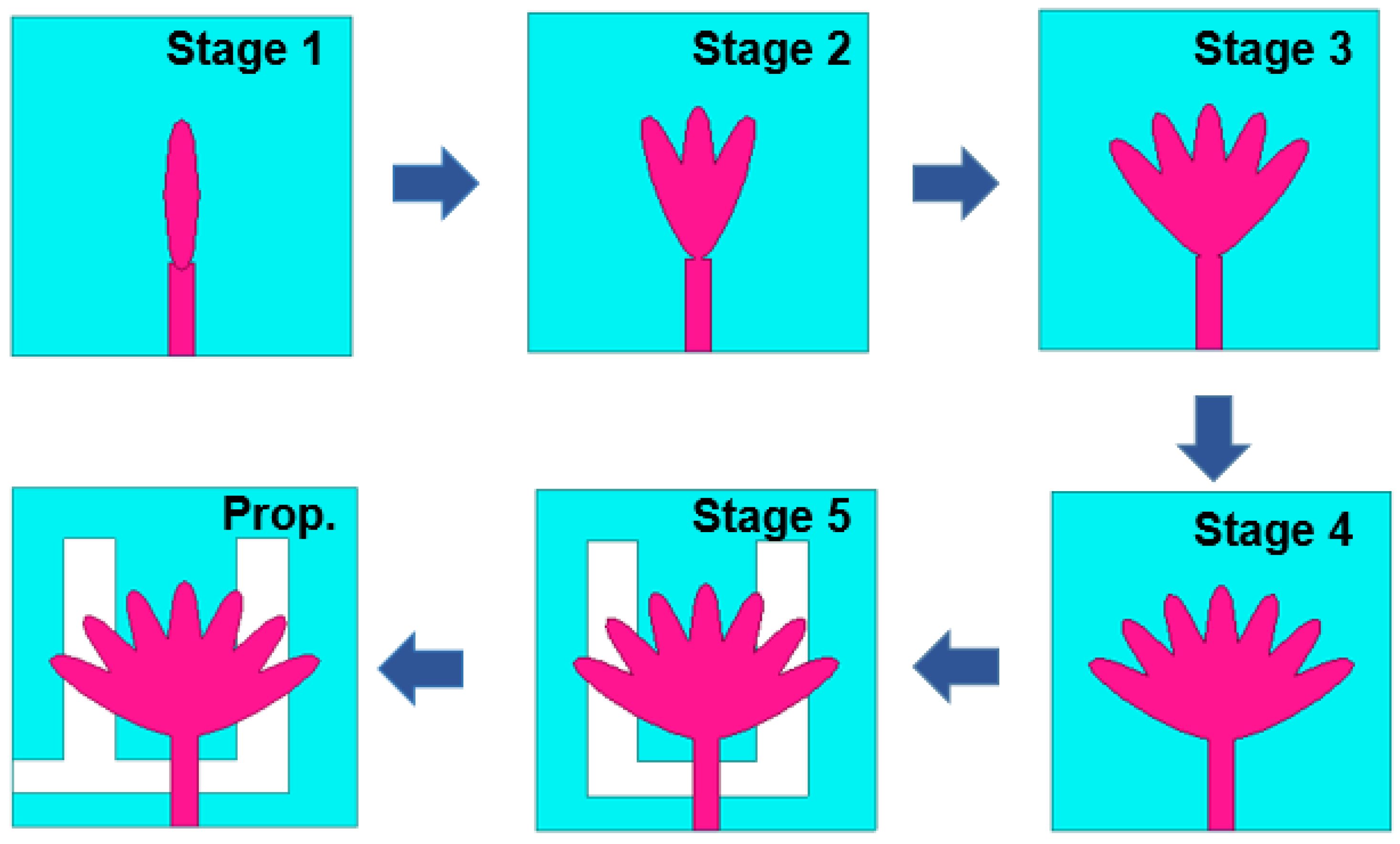




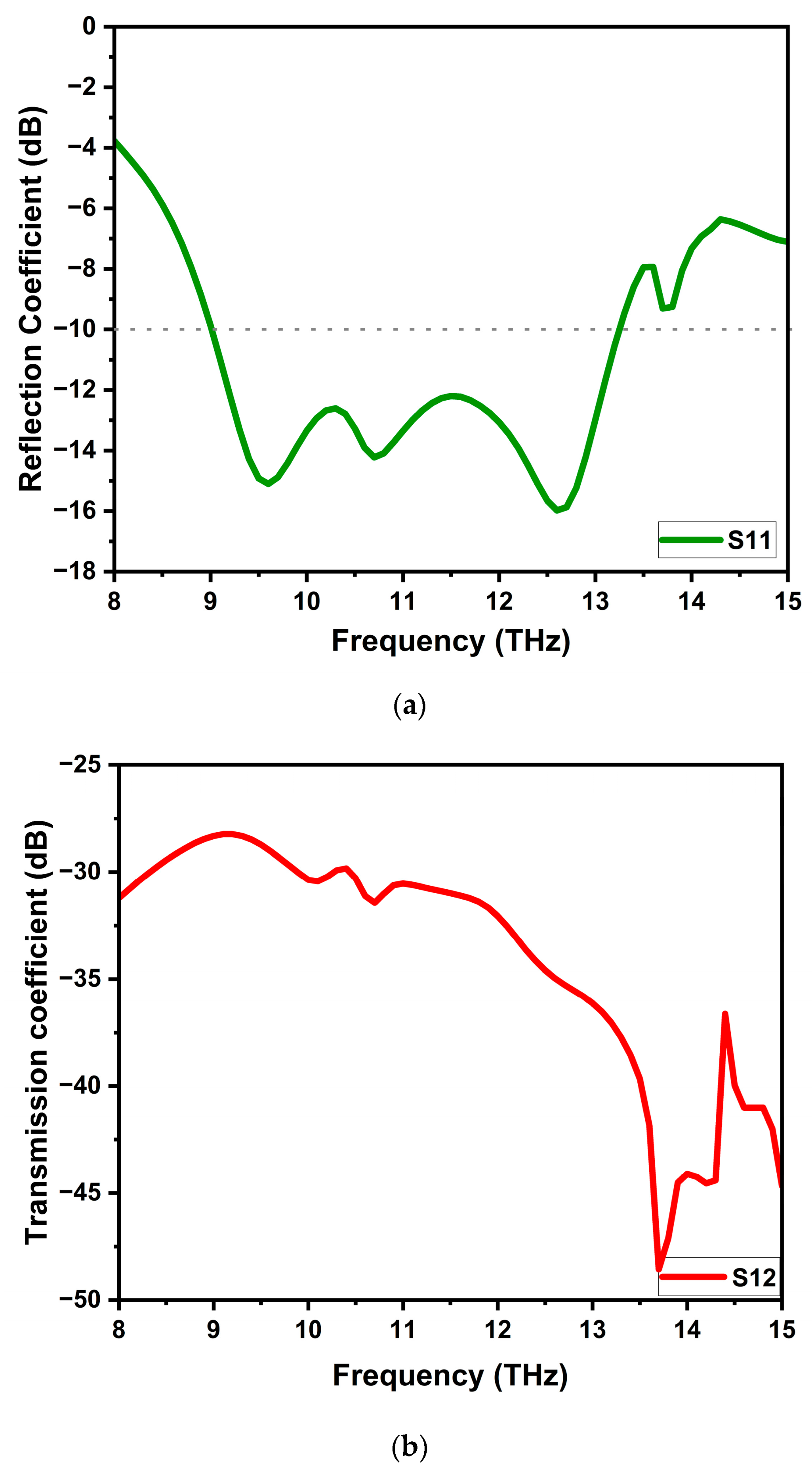

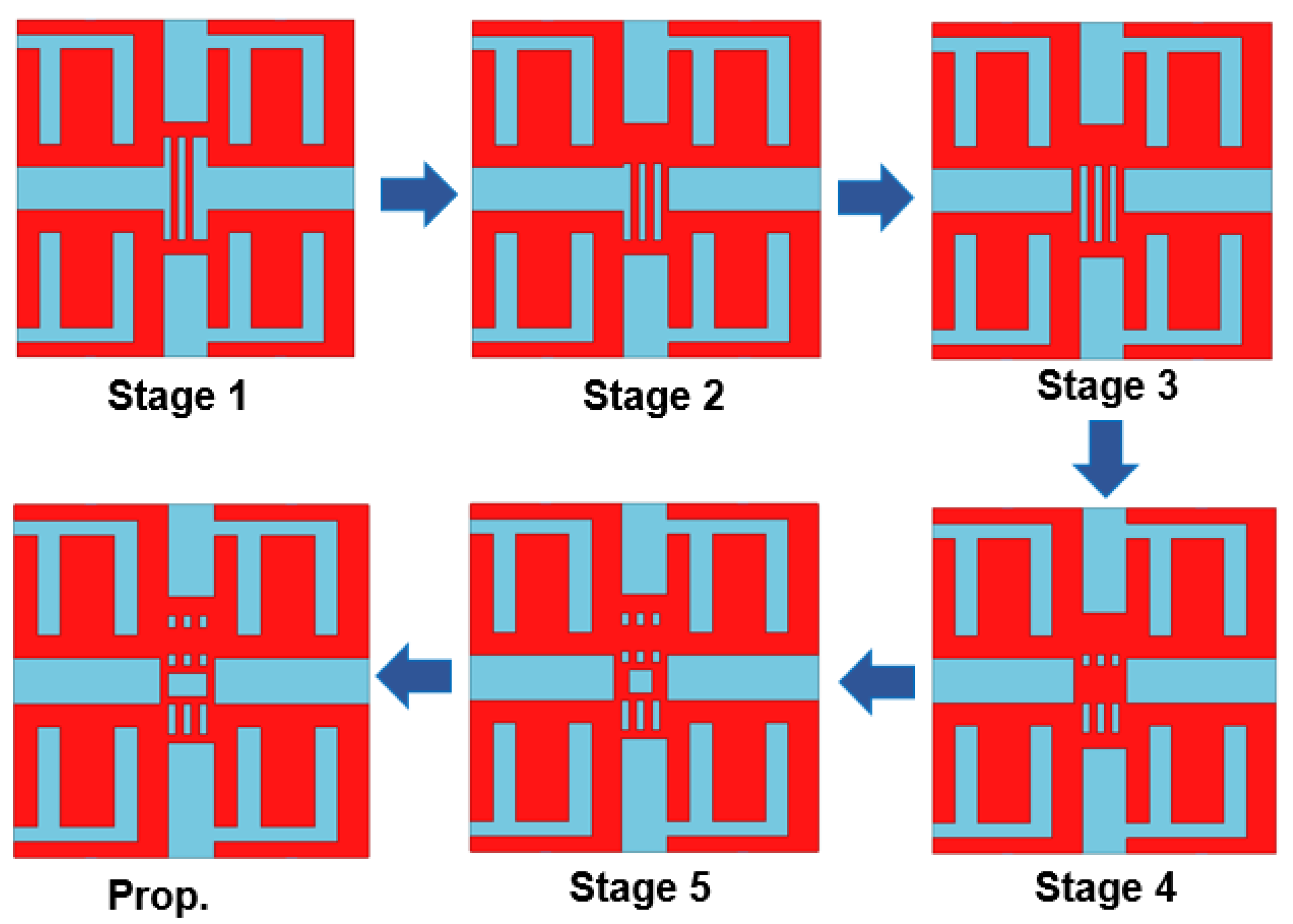
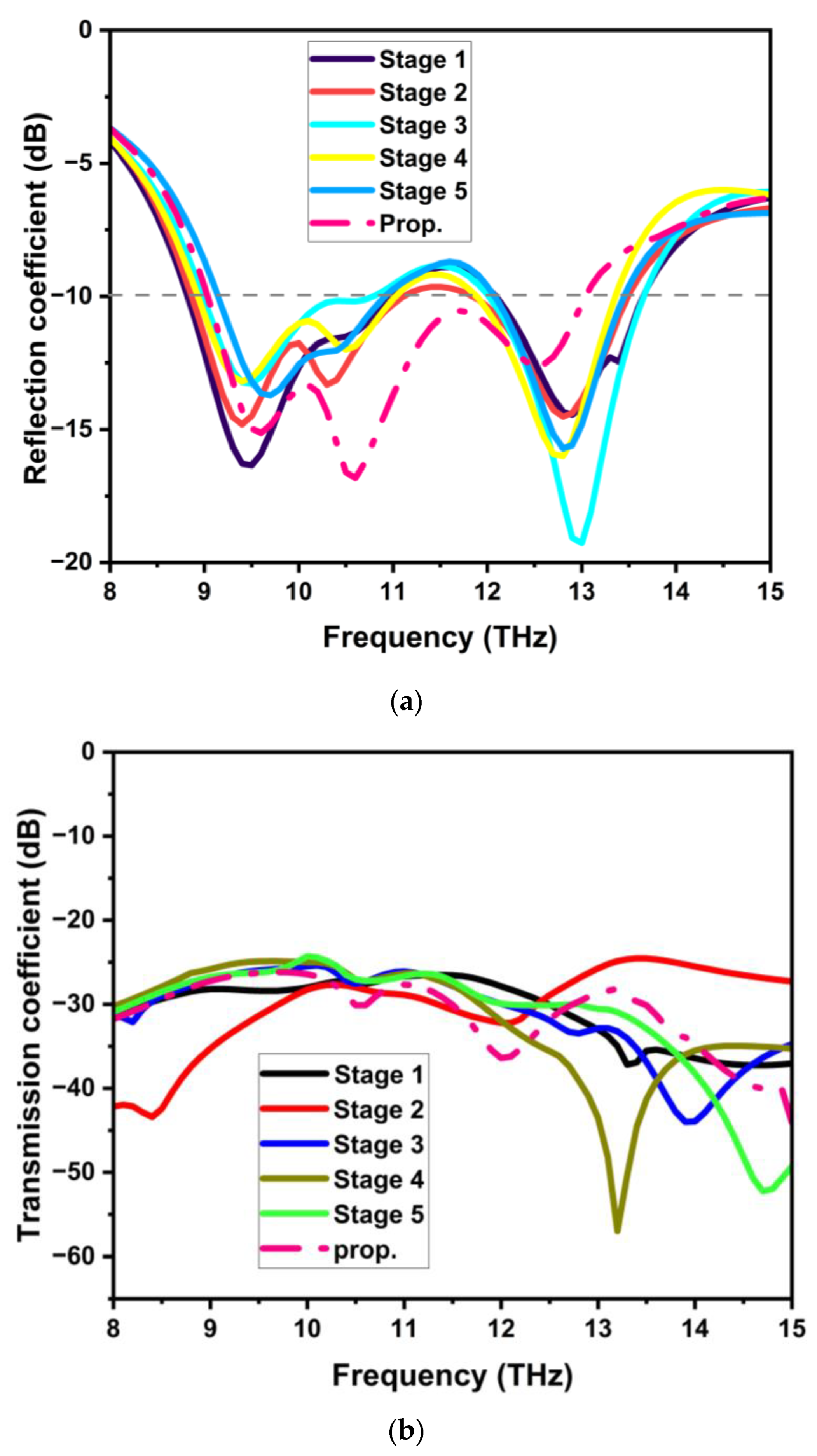

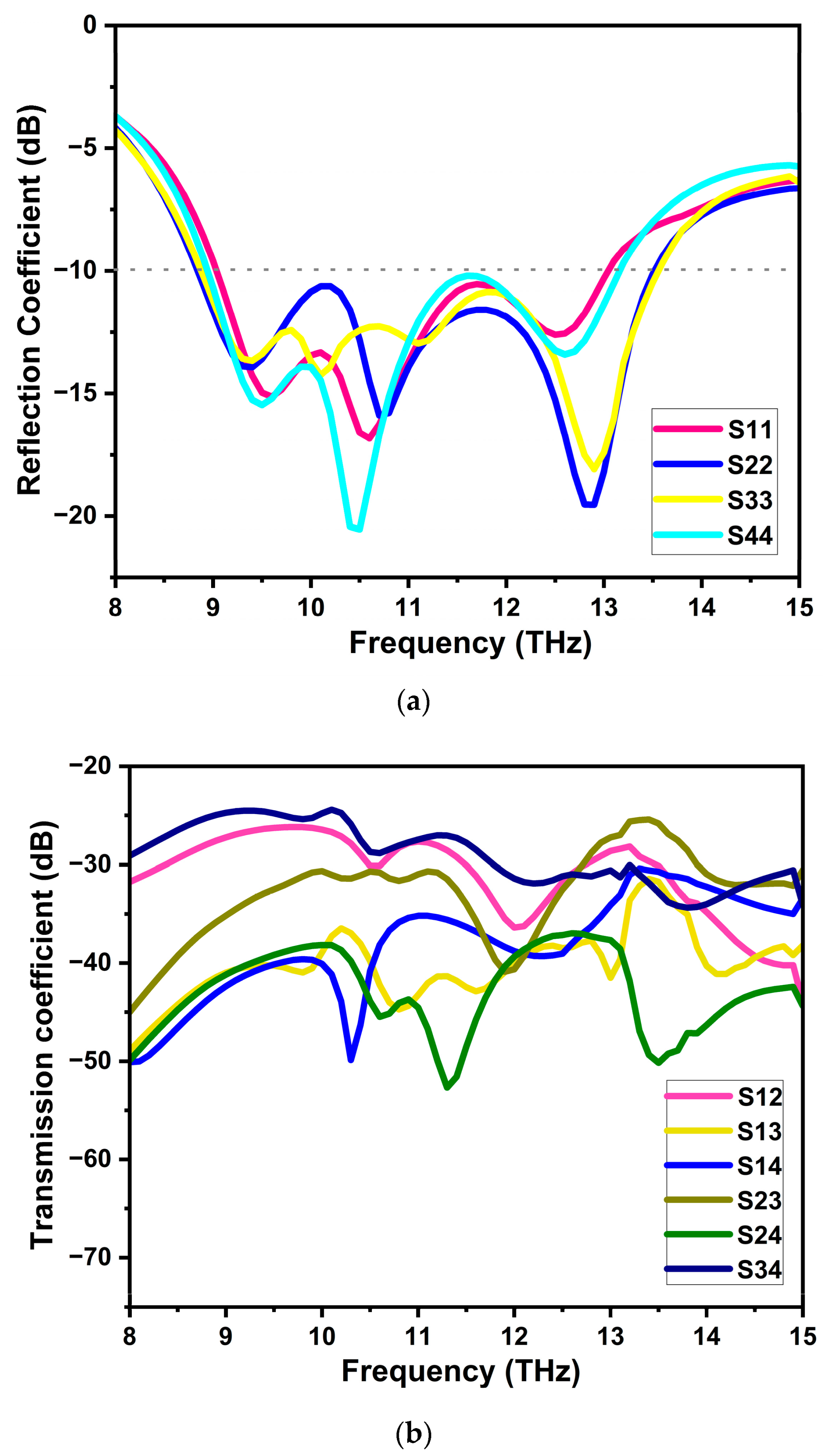
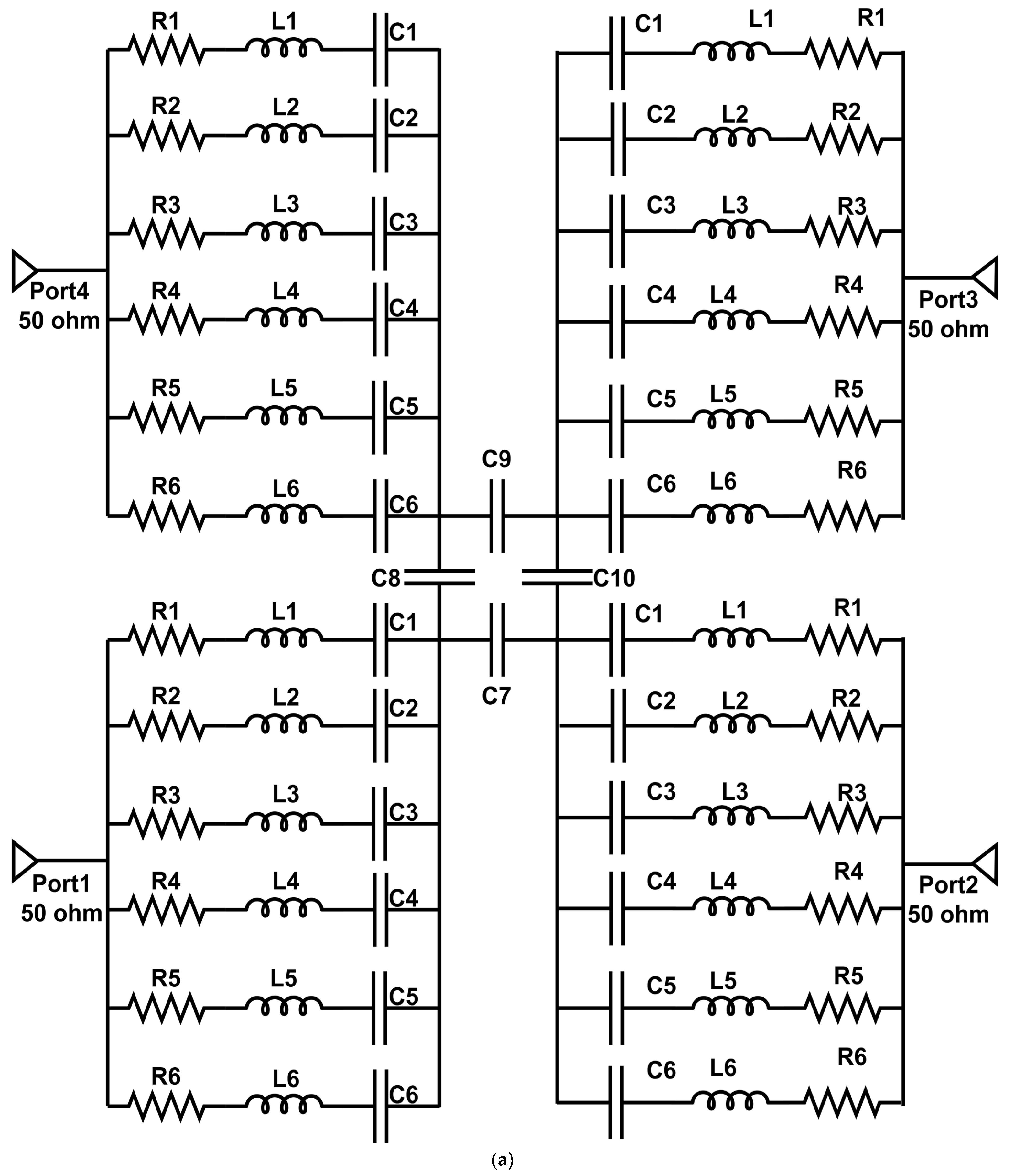


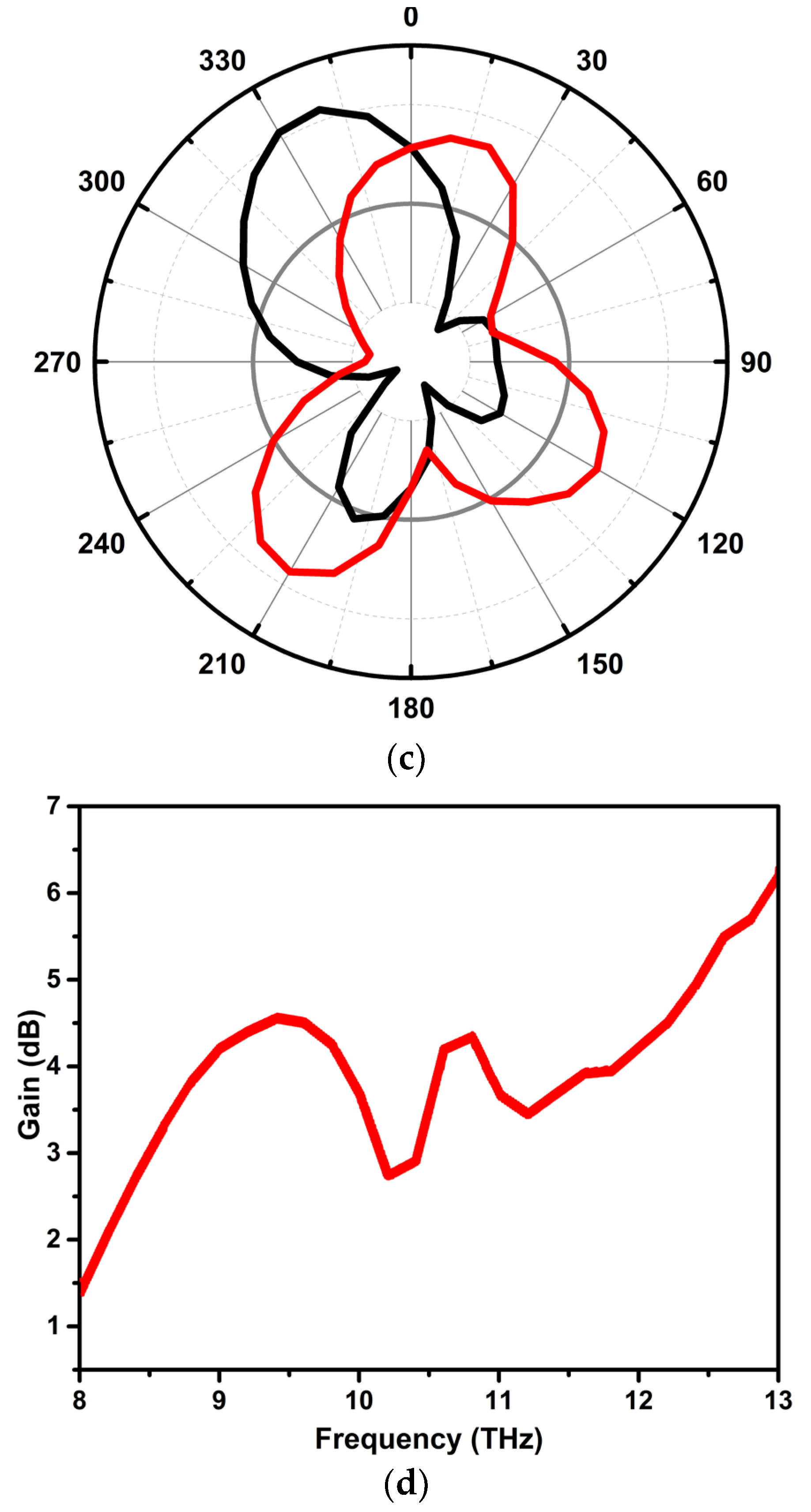

| Ref | Design Technique | Antenna Size (µm2) | Frequency Range (THz) | Radiation Pattern (dB) | Peak Gain (dB) | Complexity |
|---|---|---|---|---|---|---|
| [38] | Modified cross-slot | 110 × 110 | 2.7–4.46 | Omnidirectional | 8.5 | Moderate |
| [39] | λ/4-length path | 600 × 300 | 187–210 | Omnidirectional | 4 | Simple |
| [40] | Silicon slab | 150 × 200 × 80 | 3.96–4.1 | Directional | 6 | Complex |
| [41] | Y-shaped graphene | 60 × 110 | 0.42–0.48 | Omnidirectional | 0.12 | Complex |
| [42] | Graphene patch | 200 × 200 | 0.65–0.70 | Omnidirectional | 4.38 | Complex |
| [43] | Graphene coating | 133 × 255 | 7.76–12.51 | Omnidirectional | 8.15 | Complex |
| [44] | Metal loading on the wall of a dielectric resonator | 48 × 44 | 4.27–4.86 | Bidirectional | 6.5 | Complex |
| [45] | Fabry–Pérot cavity | 206 × 206 | 281–305 | Omnidirectional | 7.5 | Complex |
| [46] | Photonic-band-gap-based unit cells loaded with circular-shaped metallic insertion | 700 × 660 | 0.61–0.64 | Bidirectional | 8.96 | Complex |
| Prop. | Lotus-shaped radiator with DGS | 46 × 46 × 2 | 8.96–13.5 | Bidirectional | 8.96 | Simple |
| Ref | Sub. Type | Conductor Type | Antenna Size (µm3) | N Elements | Impedance Bandwidth (THz) | Isolation (dB) | Peak Gain (dB) |
|---|---|---|---|---|---|---|---|
| [31] | - | copper | 110 × 65 × 10 | 2 | 3.1–60 | >30 | 12 dB |
| [32] | polyimide | graphene | 600 × 300 × 45 | 2 | 0.276–0.711 | >20 | - |
| [33] | RT/duroid 5880 | - | 150 × 200 × 80 | 2,4,8 | 0.024, 0.028 0.037, 0.035, 0.2 | >30 | - |
| [34] | polyimide | copper | 110 × 40 × 20 | 2 | 0.8–10 | >20 | 8.6 dBi |
| [35] | Si3N4 | graphene and gold | 378 × 354 × 15 | 2 | 0.259–0.324 | >50 | 6.38 dBi |
| [36] | polyimide | graphene, alumina, and silicon | 133 × 255 | 2 | 5.5–10 | >20 | 9.14 dBi |
| [37] | polyamide | copper | 45 × 45 × 2 | 4 | 2.38–11.18 | >18 | 6.5 dBi |
| Prop. | polyamide | copper | 46 × 46 × 2 | 2,4 | 8.96–13.5 | >25 | 8.96 dB |
Disclaimer/Publisher’s Note: The statements, opinions and data contained in all publications are solely those of the individual author(s) and contributor(s) and not of MDPI and/or the editor(s). MDPI and/or the editor(s) disclaim responsibility for any injury to people or property resulting from any ideas, methods, instructions or products referred to in the content. |
© 2023 by the authors. Licensee MDPI, Basel, Switzerland. This article is an open access article distributed under the terms and conditions of the Creative Commons Attribution (CC BY) license (https://creativecommons.org/licenses/by/4.0/).
Share and Cite
Raghunath, J.; Kumar, P.; Ali, T.; Kumar, P.; Shariff Bhadrvathi Ghouse, P.; Pathan, S. A Quad-Port Nature-Inspired Lotus-Shaped Wideband Terahertz Antenna for Wireless Applications. J. Sens. Actuator Netw. 2023, 12, 69. https://doi.org/10.3390/jsan12050069
Raghunath J, Kumar P, Ali T, Kumar P, Shariff Bhadrvathi Ghouse P, Pathan S. A Quad-Port Nature-Inspired Lotus-Shaped Wideband Terahertz Antenna for Wireless Applications. Journal of Sensor and Actuator Networks. 2023; 12(5):69. https://doi.org/10.3390/jsan12050069
Chicago/Turabian StyleRaghunath, Jeenal, Praveen Kumar, Tanweer Ali, Pradeep Kumar, Parveez Shariff Bhadrvathi Ghouse, and Sameena Pathan. 2023. "A Quad-Port Nature-Inspired Lotus-Shaped Wideband Terahertz Antenna for Wireless Applications" Journal of Sensor and Actuator Networks 12, no. 5: 69. https://doi.org/10.3390/jsan12050069







